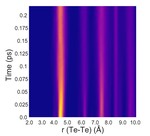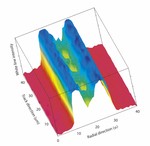Phase-Change Materials
 Schematic of proposed iPCM switching mechanism
Schematic of proposed iPCM switching mechanismThe idea of using structure for storage dates back to the 1960’s with the seminal work of Stanford Ovshinsky who proposed a four component chalcogenide alloy as a form of nonvolatile electrical memory. The higher power requirements of the phase-change memory (PCM) limited its application until the 1980’s when the pioneering work at Matsushita lead to the development of Ge-Sb-Te PCM alloys and its application to re-writeable optical discs. This has now lead to optical disc storage capacities to exceed 50 GB. Moreover, the same Ge-Sb-Te alloys are now employed in the form of storage-class memory (as epitomized by Intel’s Optane memory subsystems), a form of nonvolatile electrical memory with latencies and write times within a factor of 10 of DRAM alleviating the bottlenecks associated with the larger latency of the denser nonvolatile FLASH memory. Even more recently a new variation of electrical memory called interfacial phase-change memory (iPCM) has appeared which uses highly oriented superlattices of GeTe and Sb2Te3 to achieve more than a factor of ten reduction in energy requirements by use of what is thought to be a crystalline-crystalline transition. The figure above represents a possible atomic level model for the switching process in iPCM devices.

